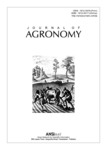Por favor, use este identificador para citar o enlazar este ítem:
http://www.alice.cnptia.embrapa.br/alice/handle/doc/1037601Registro completo de metadatos
| Campo DC | Valor | Lengua/Idioma |
|---|---|---|
| dc.contributor.author | BORGES, L. de A. B. | pt_BR |
| dc.contributor.author | MADARI, B. E. | pt_BR |
| dc.contributor.author | LEANDRO, W. M. | pt_BR |
| dc.contributor.author | FERNANDES, P. M. | pt_BR |
| dc.contributor.author | SILVA, E. A. da | pt_BR |
| dc.contributor.author | SILVA, M. R. da | pt_BR |
| dc.contributor.author | SILVA, M. A. S. da | pt_BR |
| dc.date.accessioned | 2016-02-18T11:11:11Z | pt_BR |
| dc.date.available | 2016-02-18T11:11:11Z | pt_BR |
| dc.date.created | 2016-02-18 | pt_BR |
| dc.date.issued | 2015 | pt_BR |
| dc.identifier.citation | Journal of Agronomy, v. 14, n. 1, p. 6-14, 2015. | pt_BR |
| dc.identifier.uri | http://www.alice.cnptia.embrapa.br/alice/handle/doc/1037601 | pt_BR |
| dc.description | In order to study the effect of use organic agriculture avoids the use of synthetic fertilizers and emphasizes the use of organic inputs to provide nutrients to the plants. This study had as aim to evaluate the effect of organic management time on nutrition and productivity of sugarcane. The nutrition levels and the productivity of sugarcane plantations were evaluated in areas cultivated for two, six and ten years in the organic production system compared with a sugarcane plantation cultivated for ten years in the conventional system. The sugarcane organic production system enhanced the nutrition levels of the plants and raised the crops productivity. After ten years of organic cultivation, there was an increase of 43, 42.8 and 32% in the leaf contents of potassium (K), phosphorus (P) and nitrogen (N), respectively, in relation to the conventional production system and an increase of 209% in the sugarcane productivity. The management of the fertilizers inputs used in the sugarcane organic production system is adequate for the plants nutrition, with positive result on the crops productivity. The effects are more visible after six and ten years of management in the organic production system. In the organic production system, after ten and six years, it could be suggested that the productivity was 209 and 98% higher in comparison to the productivity of the cane cultivated under the conventional system, areas Org.10 and Org.6, respectively. | pt_BR |
| dc.language.iso | eng | eng |
| dc.rights | openAccess | eng |
| dc.subject | Saccharum spp | pt_BR |
| dc.subject | Cana-de-açúcar | pt_BR |
| dc.title | Nutritional state and productivity of organic sugarcane in Goiás, Brazil. | pt_BR |
| dc.type | Artigo de periódico | pt_BR |
| dc.date.updated | 2016-02-18T11:11:11Z | pt_BR |
| dc.subject.thesagro | Rendimento | pt_BR |
| dc.subject.thesagro | Agricultura organica | pt_BR |
| dc.subject.thesagro | Nutrição vegetal | pt_BR |
| dc.subject.thesagro | Nutriente | pt_BR |
| riaa.ainfo.id | 1037601 | pt_BR |
| riaa.ainfo.lastupdate | 2016-02-18 | pt_BR |
| dc.identifier.doi | 10.3923/ja.2015.6.14 | pt_BR |
| dc.contributor.institution | LURDINEIDE DE ARAUJO BARBOSA BORGES, UFG; BEATA EMOKE MADARI, CNPAF; WILSON MOZENA LEANDRO, UFG; PAULO MARÇAL FERNANDES, UFG; EDGAR ALVES DA SILVA, JALLES MACHADO, Goianésia-GO; MARCIO RICARDO DA SILVA, JALLES MACHADO, Goianésia-GO; MELLISSA ANANIAS SOLER DA SILVA, CNPAF. | pt_BR |
| Aparece en las colecciones: | Artigo em periódico indexado (CNPAF)  | |
Ficheros en este ítem:
| Fichero | Descripción | Tamaño | Formato | |
|---|---|---|---|---|
| CNPAF2015ja.pdf | 2.54 MB | Adobe PDF |  Visualizar/Abrir |









